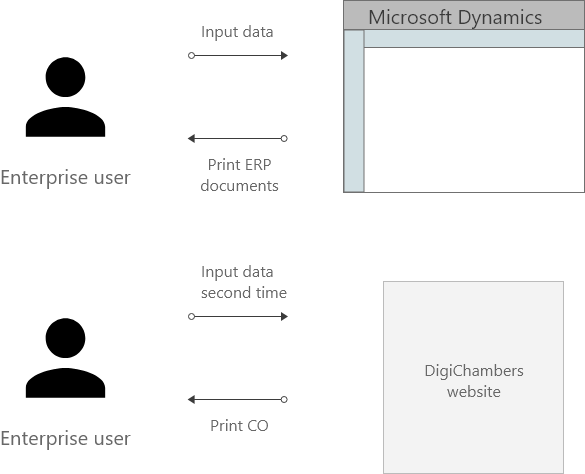In this article, the concept of an API will be discussed. The first paragraph talks about how communication over the internet is established. After that, the article zooms in on API’s. The last paragraph gives more details about the DigiChambers API.
Web communication
The web can be thought of as a large network of connected servers. Every page on the internet is stored somewhere on a remote server. Servers are big computers that are optimized to process requests.
When you type www.digichambers.be into your browser, a request goes out to the DigiChambers’ remote server. Once your browser receives a response, it interprets the code and displays the page.

From a technical point of view, your browser is a client. The DigiChambers’ server is an API. This means that every time you visit a page on the web (or in DigiChambers), you interact with some remote server’s API.
However, notice that API and the remote server are not synonyms. An API is the part of the server that receives requests, gathers necessary data from files and the database and then sends a response.

API’s
This raises the question, what’s the difference between the standard webserver’s API and an API used for automation. The most important difference here is in the way they communicate.
Regular webservers, as in the example in the last paragraph, will be required to answer in HTML for the client (web browser) to understand the response. HTML is a format which contains two elements. The first element is the data that you requested for. The second element is the presentational code. The second part tells your browser where the data should be shown on your screen. For example, it will say that the DigiChambers logo is in the upper left corner.

When moving to a automated system, the client becomes another webserver, rather than a web browser. A web server does not care about the presentation of the data, it only cares about the data. The response required by the client in this case becomes a data-centered response, which is formatted as XML or JSON.

In this context, the client-web server can be defined very broadly. It can be the actual server that makes the request but it can also be a program on this server. For DigiChambers, the consumers of the API is usually an enterprise’s ERP system, like SAP or Microsoft Dynamics.
DigiChambers API
The goal of DigiChambers and the Chambers of Commerce is to make the acquiring of the Certificate of Origin as easy as possible. At present most companies first do everything in their own systems and then log onto the DigiChambers platform. In the platform they copy all the data from their own system and then request their CO.

This is long, labor-intensive and error prone work flow. To help companies get their CO faster, with less manual labor and thus less errors, DigiChambers allows connection automatically through the DigiChambers API.
Through this API it is possible to set up a connection from within a company’s ERP software to DigiChambers so that with the click of a button within the ERP software the CO is also requested.

By now you probably wonder where you can acquire this magnificent piece of software that will solve all your problems. For this, please read on in this article.
Was this helpful?
3 / 1